It looks like you're using an Ad Blocker.
Please white-list or disable AboveTopSecret.com in your ad-blocking tool.
Thank you.
Some features of ATS will be disabled while you continue to use an ad-blocker.
20
share:
With the religious and ethnic fault lines of Israel and her neighbours once again very much in the news, i'm continuing my case for constructions of
the Nephilim in the region, in particular Hebron, were nowhere are the dividing lines more literally seen, a continuation then from this thread.
www.abovetopsecret.com...
The emphasis will be on two Hebron sites contained within two sacred enclosures/Temenos, that of Mamre were Abraham met and dined with Yahweh and two Angels beside a great oak Terebinth, and the burial caves he purchased at Machpelah.
There is no record of how Yahweh and his Angels arrived at Mamre, or were they departed to afterward, if indeed they left, but the site was celebrated by all peoples of the region as a place of visitation, an enclosre was built around the tree and well with an altar within the centre.
www.netours.com...
It is unknown who first constructed the enclosure, which contains masonry of the same style as at the Cave of Machpelah Temenos, as well as those at Jerusalem and Baalbek, Vespasian seems to have demolished it at the time of the Bar Kochba revolt, Hadrian rebuilt it, and then again Constantine who built a church within its Eastern end.
Because it contains masonry generally labelled 'Herodian' some might consider it constructed by Herod, but there is nothing that attributes the site to him, and during the classical period it appears to have been dedicated principally to Hermes-Mercury, messenger of the Gods.
The extent of quality masonry identical to that seen at Machpelah isn't great, a case can be made that whilst constructed at the same time only leftovers of the quality cut stones were used, with the rest of the construction of large but lesser quality stones
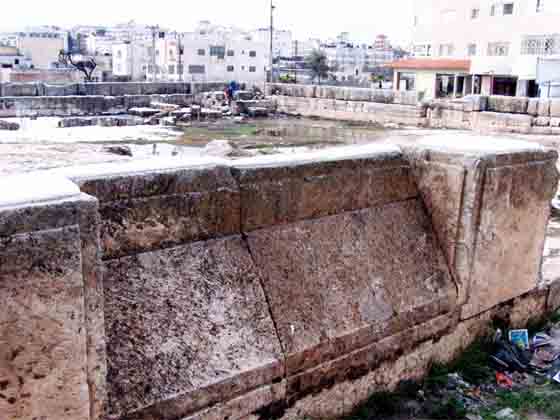
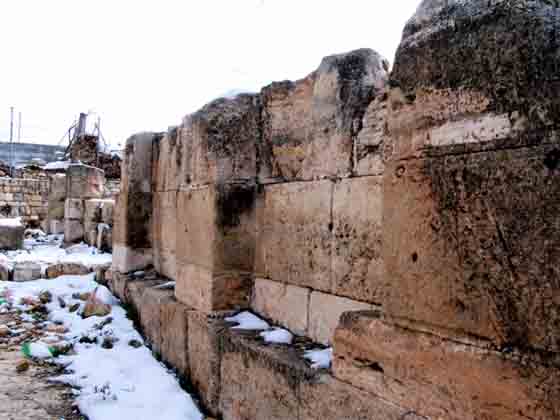
It's difficult to know if the height would have been as great as at Machpelah, especially as later reconstructions have placed larger stones above smaller thus making it difficult to establish the load bearing capacity of the lower courses
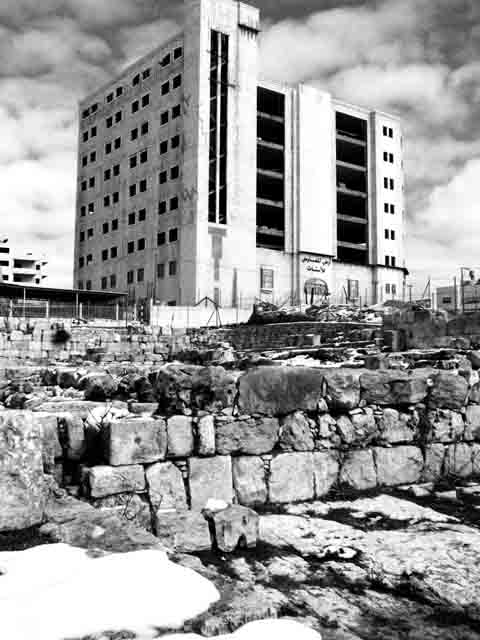
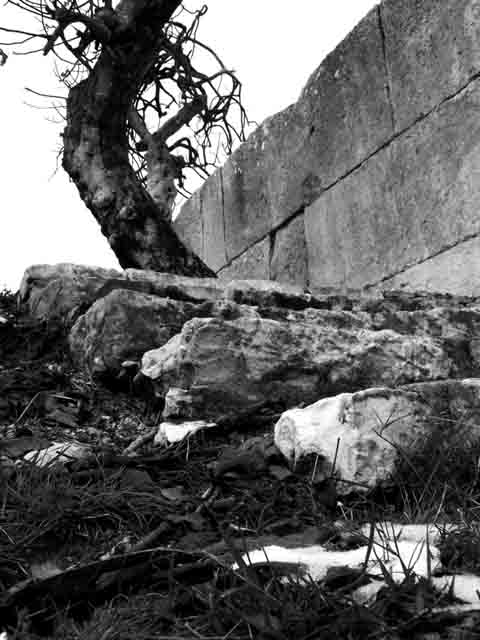
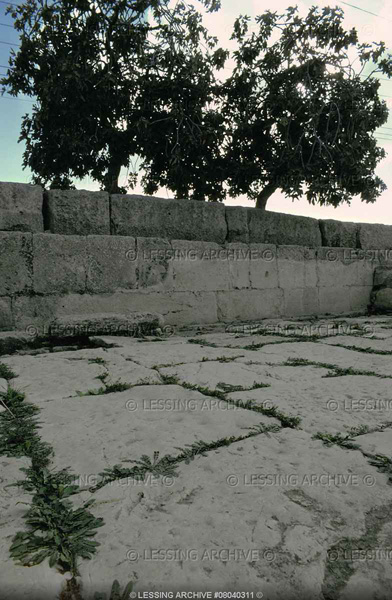
It's important to note that at the time Abraham is supposedly having his meeting with Yahweh and the Angels there was a strongly established city at Hebron,
cojs.org...
Indeed it is considered that Abraham purchased the caves at the gates of the bronze age II city,
So one finds that the visitation at Mamre is within the environs of a well established city, and it is later seen that all peoples and religions of the region commemorated these events. Josephus attributes the Temenos at Machpelah to the time of the patriarchs, never mentioning Herod in connection with the site, i would consider a Middle to Late bronze age date for the enclosures feasible, in terms of contextual relevance to the Caananite occupants, and comparable construction capabilities, the Caananite cities were described as being walled up to Heaven,
If of Caananite construction obviously there take would differ from that of the Hebrews.
www.abovetopsecret.com...
The emphasis will be on two Hebron sites contained within two sacred enclosures/Temenos, that of Mamre were Abraham met and dined with Yahweh and two Angels beside a great oak Terebinth, and the burial caves he purchased at Machpelah.
There is no record of how Yahweh and his Angels arrived at Mamre, or were they departed to afterward, if indeed they left, but the site was celebrated by all peoples of the region as a place of visitation, an enclosre was built around the tree and well with an altar within the centre.
The Jerusalem Talmud (IV/7,19) mentions a great fair held at a place called Botnah, which means terebinth. It was the biggest fair in the land, said the Rabbis, bigger than the ones at Acco and Gaza. They advised Jews not to attend, because idolatrous practices were rampant. This was probably the same place that Byzantine writers called Terebinthus, where a great tree stood and where an annual pagan fair was held in the summer. They are the first, apparently, to use the name Mamre as an alternative for Terebinthus
We have a detailed description of the fair from Sozomen of Gaza. Writing in the 5th century, he describes the pagan activities, which were accompanied by "hilarity." The Emperor Constantine forbade them, he tells us, and ordered that a church be built on the spot. Sozomen begins in the present tense but shifts to the past, so it is unclear whether, despite the decree, the hilarity continued.
of Mature This place is now called Terebinthus, and is about fifteen stadia distant from Hebron, which lies to the south, but is two hundred and fifty stadia distant from Jerusalem. It is recorded that here the Son of God appeared to Abraham, with two angels, who had been sent against Sodom, and foretold the birth of his son. Here the inhabitants of the country and of the regions round Palestine the Phoenicians, and the Arabians, assemble annually during the summer season to keep a brilliant feast; and many others, both buyers and sellers, resort thither on account of the fair. Indeed, this feast is diligently frequented by all nations: by the Jews, because they boast of their descent from the patriarch Abraham; by the Pagans, because angels there appeared to men; and by Christians, because He who for the salvation of mankind was born of a virgin, afterwards manifested Himself there to a godly man. This place was moreover honored fittingly with religious exercises. Here some prayed to the God of all; some called upon the angels, poured out wine, burnt incense, or offered an ox, or he-goat, a sheep, or a cock
The sacrificial altar was probably in the middle, where a black segment appears in the diagram above. Here were found metal bells, rings, earrings, pieces of crystal, animal bones and a great many rooster feet. The rooster was holy to Hermes-Mercury, who was not only the messenger but also the god of commerce. An inscription honoring him turned up as well
www.netours.com...
It is unknown who first constructed the enclosure, which contains masonry of the same style as at the Cave of Machpelah Temenos, as well as those at Jerusalem and Baalbek, Vespasian seems to have demolished it at the time of the Bar Kochba revolt, Hadrian rebuilt it, and then again Constantine who built a church within its Eastern end.
Because it contains masonry generally labelled 'Herodian' some might consider it constructed by Herod, but there is nothing that attributes the site to him, and during the classical period it appears to have been dedicated principally to Hermes-Mercury, messenger of the Gods.
The extent of quality masonry identical to that seen at Machpelah isn't great, a case can be made that whilst constructed at the same time only leftovers of the quality cut stones were used, with the rest of the construction of large but lesser quality stones


It's difficult to know if the height would have been as great as at Machpelah, especially as later reconstructions have placed larger stones above smaller thus making it difficult to establish the load bearing capacity of the lower courses



It's important to note that at the time Abraham is supposedly having his meeting with Yahweh and the Angels there was a strongly established city at Hebron,
During Early Bronze Age III (2600–2300 B.C.E.) the city was protected by a massive city wall over 20 feet thick. In 1964 Hammond excavated a 40-foot-long segment of this wall on the south side of the ancient city. It was built of large field stones, some more than 3 feet long. The flat top of this wall rose 8 feet above bedrock and may have been the base for a mud brick superstructure. In 1999, another segment of this wall, more than 45 feet long, was discovered on the north side of the tell by Eisenberg, who confirmed the structure’s Early Bronze III date
cojs.org...
Indeed it is considered that Abraham purchased the caves at the gates of the bronze age II city,
The Middle Bronze II gateway with its massive tower may have found its way onto the pages of the Bible. In the account of Sarah’s death at Hebron, Abraham is reported to have bought the cave of Machpelah from Ephron the Hittite as a burial place for his wife. The cave became Abraham’s family tomb. This transaction took place in the hearing of “all who entered the gate” of the city (Genesis 23:10). When the Biblical author wrote these words he might well have had this gate and tower complex in mind since Hammond determined that it continued in use from Abraham’s time until the end of Iron Age II
So one finds that the visitation at Mamre is within the environs of a well established city, and it is later seen that all peoples and religions of the region commemorated these events. Josephus attributes the Temenos at Machpelah to the time of the patriarchs, never mentioning Herod in connection with the site, i would consider a Middle to Late bronze age date for the enclosures feasible, in terms of contextual relevance to the Caananite occupants, and comparable construction capabilities, the Caananite cities were described as being walled up to Heaven,
The text then adds, “And we also saw Children of Anak there” (Numbers 13:28). The Children of Anak are mentioned only in connection with Hebron, which indicates it may have been Hebron’s high and massive Middle Bronze II wall, still in use centuries after it was built, that was in the mind of the Biblical writer when he composed the spy narrative. The Deuteronomic version of the same event employs picturesque hyperbole in describing Canaanite cities like Hebron as being “walled up to heaven” (Deuteronomy 2:28).
If of Caananite construction obviously there take would differ from that of the Hebrews.
In considering the context for the caves at Machpelah and the related enclosure the given context is that of the burial place of the patriarchs,
including the later addition of Adam and Eve, as well as it being the entrance to the Garden of Eden, as mentioned in the Zohar
This is speculated upon in Kabbalistic thought to the extent;
godssecret.wordpress.com...
An angle that more intrigues me though is whether this was a place of Royal burial for the Nephilim rulers of Hebron pre-conquest by the Hebrews. One little known fact is that the subterranean entrance corridor to the caves is of the same type of 'Herodian' masonry as the outer enclosure, as the only known entranceway into the caves is contempary with the outer enclosure, if attributed to Herod then that would mean he created the entire complex, which is a non-starter, the subterranean corridor thus suggests the the outer enclosure dates to first period of usage.
An account of recent incursion into the lower levels from here;
www.hebron.com...
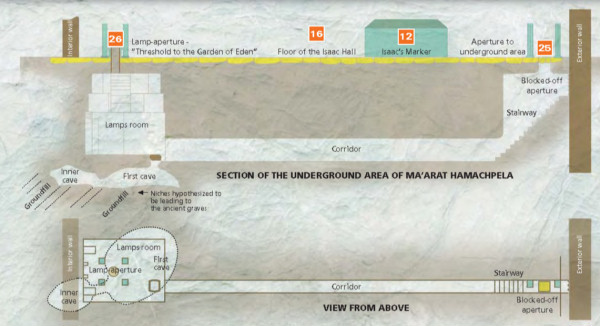
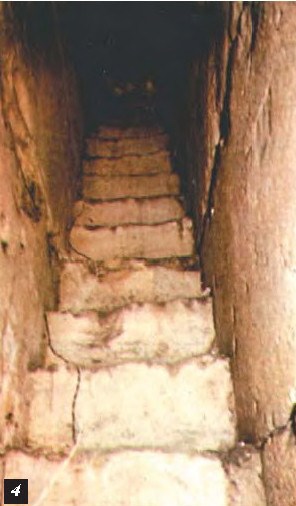
To establish a historical context one needs to consider the many other cave burials from around Hebron dating to the bronze age;

en.wikipedia.org...
The Anakim had extensive trade it would seem with the Egyptians and were known to them.
In summary then it seems to me that given the interconnection between the enclosures at Mamre and Machpelah the relationship was that Mamre was sacred across many traditions as a place were man encountered Angels and that Machpelah was equally sacred as the place were the children of union between man and the Angels were buried, the rulers of Caananite Hebron...the Hebrews having variation on this in determining their origins relative to the traditions.
The Zohar, a late 13th-century mystical treatise, also supports the belief that Adam and Eve are buried at Machpelah. In addition, the Zohar locates the cave of Machpelah next to the Garden of Eden and suggests that through this cave the souls of the righteous may enter Paradise (Zohar, Lech Lecha 95; Zohar Chadash 58:27).
This is speculated upon in Kabbalistic thought to the extent;
The name Machpelah means folded. In the Zohar we are told that the field and cave rests on a 2 fold area namely the world above and world below. Thus through this spiritual gate all souls pass when they leave this world
godssecret.wordpress.com...
An angle that more intrigues me though is whether this was a place of Royal burial for the Nephilim rulers of Hebron pre-conquest by the Hebrews. One little known fact is that the subterranean entrance corridor to the caves is of the same type of 'Herodian' masonry as the outer enclosure, as the only known entranceway into the caves is contempary with the outer enclosure, if attributed to Herod then that would mean he created the entire complex, which is a non-starter, the subterranean corridor thus suggests the the outer enclosure dates to first period of usage.
An account of recent incursion into the lower levels from here;
www.hebron.com...


To establish a historical context one needs to consider the many other cave burials from around Hebron dating to the bronze age;
Hammond had found remains of Late Bronze Age occupation in six different areas.6 Hebron was in fact an active city during the Late Bronze Age, particularly in Late Bronze II. In some cases, Hammond determined that houses built in the Middle Bronze Age continued to be used in the Late Bronze Age, as shown by the pottery found in them.
A room in one structure located in Area 6 in the center of the ancient city yielded fragments of typical Late Bronze Age painted pottery and imported Cypriot “base ring” vessels. In the same room (which I designated Room 1096 in my research) Hammond discovered a Late Bronze II arrowhead and a limestone scarab bearing the prenomen of Pharaoh Ramesses II, User Ma’at Ra Setep N Ra (Ramesses’ throne name).7 Ramesses II dominated Canaan during much of his long reign (1290–1224 B.C.E.), near the end of the Late Bronze Age. And he is often thought to have been the pharaoh of the Exodus.
Hammond also found a Late Bronze Age burial cave south of the city wall line. Designated Tomb 2, it had unfortunately been looted shortly before his arrival at Tell Rumeide. The thieves left behind only scattered Late Bronze Age pottery sherds. But those were enough to establish the date of the tomb.
Another Late Bronze Age tomb just outside the north city wall line was cleared in 1998 by Israeli archaeologist Yuval Peleg. He found 53 burials, together with pottery vessels, bronze objects and scarabs of the Egyptian pharaohs Tutmoses III (1479–1425 B.C.E.) and Amenophis III (1391–1353 B.C.E.).8
All in all, the evidence is strong that Hebron was a thriving city in the Late Bronze Age just before the time the Bible says the Israelites captured it.

The Egyptian Execration texts of the Middle Kingdom[4] (2055-1650 BC) mention a list of political enemies in Canaan, and among this list are a group called the "ly Anaq" or people of Anaq
en.wikipedia.org...
The Anakim had extensive trade it would seem with the Egyptians and were known to them.
In summary then it seems to me that given the interconnection between the enclosures at Mamre and Machpelah the relationship was that Mamre was sacred across many traditions as a place were man encountered Angels and that Machpelah was equally sacred as the place were the children of union between man and the Angels were buried, the rulers of Caananite Hebron...the Hebrews having variation on this in determining their origins relative to the traditions.
edit on 20-11-2012 by Kantzveldt because: (no reason given)
Thanks for the info, barely into it so far but will continue.
Just had to make a comment real quick.
Is it a coincidence that both visitor angels were said to have came there and it was also attributed to Mercury the messenger? That is a mighty coincidence I must say.
Now to continue the read.
Just had to make a comment real quick.
Is it a coincidence that both visitor angels were said to have came there and it was also attributed to Mercury the messenger? That is a mighty coincidence I must say.
Now to continue the read.
reply to post by muzzleflash
No i don't think thats a coincidence but how the tradition was best understood during the classical period, that the Angels were messengers/intermediaries in the manner of Hermes, and that the site became a meeting place, site of the fair and trade of which he was also patron...in general all transactions and covenants.
No i don't think thats a coincidence but how the tradition was best understood during the classical period, that the Angels were messengers/intermediaries in the manner of Hermes, and that the site became a meeting place, site of the fair and trade of which he was also patron...in general all transactions and covenants.
edit on 20-11-2012 by Kantzveldt because: (no reason given)
Here is a link for people to glance at for more background.
timeline wiki
Also some key terms worth investigating.
Neo-Canaanite
Neo-Assyrian
Neo-Babylonian
Hittites
By the way, Phoenicia is just the word the Greeks called the civilization during those periods, which was located in present day Palestine-Israel. No known records indicate they actually called themselves by that term.
timeline wiki
Also some key terms worth investigating.
Neo-Canaanite
Neo-Assyrian
Neo-Babylonian
Hittites
By the way, Phoenicia is just the word the Greeks called the civilization during those periods, which was located in present day Palestine-Israel. No known records indicate they actually called themselves by that term.
edit on 20-11-2012 by muzzleflash because: (no reason given)
reply to post by Kantzveldt
You bring up " Nephilim rulers of ancient Hebron" and this confuses me as it has many potential meanings.
Please define this term " Nephilim " in the context of your suppositions, if you dont mind.
You bring up " Nephilim rulers of ancient Hebron" and this confuses me as it has many potential meanings.
Please define this term " Nephilim " in the context of your suppositions, if you dont mind.
Originally posted by muzzleflash
By the way, Phoenicia is just the word the Greeks called the civilization during those periods, which was located in present day Palestine-Israel. No known records indicate they actually called themselves by that term.edit on 20-11-2012 by muzzleflash because: (no reason given)
I believe they called themselves after the cities they came from or were associated with
reply to post by muzzleflash
Caananite Hebron was named after Arba, the father of Anak whose descendants were considered Nephilim, the Anakim.
Numbers 13:28
"Nevertheless, the people who live in the land are strong, and the cities are fortified and very large; and moreover, we saw the descendants of Anak there."
The land, through which we have gone to spy it out, is a land that devours its inhabitants, and all the people that we saw in it are of great height. And there we saw the Nephilim (the sons of Anak, who come from the Nephilim), and we seemed to ourselves like grasshoppers, and so we seemed to them
Joshua 15:13-14
"Now he gave to Caleb the son of Jephunneh a portion among the sons of Judah, according to the command of the Lord to Joshua, namely, Kiriath-arba, Arba being the father of Anak (that is Hebron). And Caleb drove out from there the three sons of Anak: Sheshai and Ahiman and Talmai, the children of Anak.".
Caananite Hebron was named after Arba, the father of Anak whose descendants were considered Nephilim, the Anakim.
Numbers 13:28
"Nevertheless, the people who live in the land are strong, and the cities are fortified and very large; and moreover, we saw the descendants of Anak there."
The land, through which we have gone to spy it out, is a land that devours its inhabitants, and all the people that we saw in it are of great height. And there we saw the Nephilim (the sons of Anak, who come from the Nephilim), and we seemed to ourselves like grasshoppers, and so we seemed to them
Joshua 15:13-14
"Now he gave to Caleb the son of Jephunneh a portion among the sons of Judah, according to the command of the Lord to Joshua, namely, Kiriath-arba, Arba being the father of Anak (that is Hebron). And Caleb drove out from there the three sons of Anak: Sheshai and Ahiman and Talmai, the children of Anak.".
edit on 20-11-2012 by Kantzveldt because: (no reason given)
reply to post by Kantzveldt
Whoa OK, actual Nephilim huh?
Hmmm....
Being giants it would explain how they lifted these huge stones, in a funny way.
What if? You never know...
Whoa OK, actual Nephilim huh?
Hmmm....
Being giants it would explain how they lifted these huge stones, in a funny way.
What if? You never know...
reply to post by Kantzveldt
Fascinating research, and thank you for going to the trouble! I have been making similar connections to that which might be kin to your Nephilim, but on the other side of the ancient world. It is fresh conjecture because of the lack of research that has occurred there, unlike in the biblical lands where so much has been done, but lately Google Earth has been uncovering regions in the Americas that so far can't be explained well in the same context.
For example, it is not clear how places like Puma Punku could have been constructed in the time frame they are dated, simply because the structural enforcements are so large, like the ones you show here. In addition, the similar mythologies of these regions (Middle East and proto-Americas) speak of "giants" that inhabited the areas before mankind.
Is it so far off to consider there could have been some sort of human-related evolution of giants that eventually could not procreate because they were too big? The myths of giants seem to coincide with myths of cannibals, as if the giants eventually took to eating their own when there was no other way.
This would not be the first time in the evolution of modern humans where "the meek" would inherit the Earth. There is good evidence that whatever wiped out the dinosaurs was the "last straw" as the dinosaurs were already doomed by their own inability to find enough to eat to sustain them. They were too big.
Incidentally, another part of your reseach that is fascinating on the level of etymology is the source of the name "Mamre." It has kin with the source of the words "Memory" and "Metatron." But that's a whole 'nother thread!
Fascinating research, and thank you for going to the trouble! I have been making similar connections to that which might be kin to your Nephilim, but on the other side of the ancient world. It is fresh conjecture because of the lack of research that has occurred there, unlike in the biblical lands where so much has been done, but lately Google Earth has been uncovering regions in the Americas that so far can't be explained well in the same context.
For example, it is not clear how places like Puma Punku could have been constructed in the time frame they are dated, simply because the structural enforcements are so large, like the ones you show here. In addition, the similar mythologies of these regions (Middle East and proto-Americas) speak of "giants" that inhabited the areas before mankind.
Is it so far off to consider there could have been some sort of human-related evolution of giants that eventually could not procreate because they were too big? The myths of giants seem to coincide with myths of cannibals, as if the giants eventually took to eating their own when there was no other way.
This would not be the first time in the evolution of modern humans where "the meek" would inherit the Earth. There is good evidence that whatever wiped out the dinosaurs was the "last straw" as the dinosaurs were already doomed by their own inability to find enough to eat to sustain them. They were too big.
Incidentally, another part of your reseach that is fascinating on the level of etymology is the source of the name "Mamre." It has kin with the source of the words "Memory" and "Metatron." But that's a whole 'nother thread!
reply to post by alumnathe
It's true as you state that the best evidence is from the Near East, in that in the case of Hebron we know where and when they lived from both Hebrew and Egyptian sources, and have evidence of what they constructed, though i have been making the case in these threads that is greatly underestimated and that quality construction at Jerusalem and Baalnek, as well as Hebron could perhaps be attributed to them.
There is also of course an entire corpus of literature regarding the Watchers that the Nephilim were considered to be the descendants of, things are never so straight forward in South America.
reply to post by UnifiedSerenity
You're welcome....
It's true as you state that the best evidence is from the Near East, in that in the case of Hebron we know where and when they lived from both Hebrew and Egyptian sources, and have evidence of what they constructed, though i have been making the case in these threads that is greatly underestimated and that quality construction at Jerusalem and Baalnek, as well as Hebron could perhaps be attributed to them.
There is also of course an entire corpus of literature regarding the Watchers that the Nephilim were considered to be the descendants of, things are never so straight forward in South America.
reply to post by UnifiedSerenity
You're welcome....
edit on 21-11-2012 by Kantzveldt because: (no reason given)
I suppose what one really needs to find at Hebron are actual remains of a giant, taking into account bronze age cave burials are still being
discovered in recent times that may not be impossible, indeed the cave complex at Machpelah has related accounts of passageways and sepulche that were
not seen in the most recent below ground incursions, so that is possibly more extensive than presently known.
What would be required is to find the remains of several individuals, such as were found in the South of France dating back to the Neolithic era.
en.wikipedia.org...
The suggested continuity from the Neolithic through to the bronze age is interesting, i would expect the same at Hebron
What would be required is to find the remains of several individuals, such as were found in the South of France dating back to the Neolithic era.
The bones were discovered by the anthropologist Georges Vacher de Lapouge at the Bronze Age cemetery of Castelnau-le-Lez, France in the winter of 1890. His findings were published in the journal La Nature, Vol. 18, 1890.[1][2] The height of the individual was estimated at about 3.5 m (11 ft 6 in) according to de Lapouge, and the bones were dated to the Neolithic period, since they were found at the very bottom of the Bronze Age burial tumulus. The journal includes a photo engraving of what was identified as the humerus, tibia, and femoral mid-shaft of the giant compared to a normal size humerus in the center.
The bones of the Castelnau giant were studied at the University of Montpellier and examined by M. Sabatier, professor of Zoology, at the University of Montpellier, and M. Delage, professor of paleontology at the University of Montpellier, in addition to other anatomists. In 1892 the bones were carefully studied by Dr. Paul Louis André Kiener, professor of pathological anatomy at Montpellier School of Medicine, for which he admitted they represented a "very tall race", but nevertheless found them abnormal in dimensions and apparently of "morbid growth."[3]
It is of some interest that in 1894, press accounts mentioned a further discovery of bones of human giants unearthed at a prehistoric cemetery at Montpellier, France (5 km Southwest of Castelnau) while workers were excavating a water works reservoir. Skulls "28, 31, and 32 inches in circumference" were reported alongside other bones of gigantic proportions which indicated they belonged to a race of men "between 10 and 15 feet in height." The bones were reportedly sent to the Paris Academy for further study
en.wikipedia.org...
The suggested continuity from the Neolithic through to the bronze age is interesting, i would expect the same at Hebron
Originally posted by Kantzveldt
reply to post by alumnathe
It's true as you state that the best evidence is from the Near East, in that in the case of Hebron we know where and when they lived from both Hebrew and Egyptian sources, and have evidence of what they constructed, though i have been making the case in these threads that is greatly underestimated and that quality construction at Jerusalem and Baalnek, as well as Hebron could perhaps be attributed to them.
There is also of course an entire corpus of literature regarding the Watchers that the Nephilim were considered to be the descendants of, things are never so straight forward in South America.
There is at least one account of giants in SA. 20feet tall,6 fingers and toes, came in ships and brought no females with them. They tried to breed with local women but would cause hemorrhaging and death. Women that did get pregnant could not pass the large babies through the birth cannal and so died or had the children torn from them. One day, so the story goes an "angel" with a flaming sword showed up and killed them all. Bone fragments are still found at the location of the battle. There is even a small museum there today with a collection of molars that are about three times larger than regular human molars. This story come out of a book, with photos of the teeth, called Folk Stories of South America. This work is not one of "those" books you may be thinking about. I will dig it out and give you the details.
Absolutely fascinating thread OP, and well articulated.
I believe the recent archeoligical findings in reference to the ancient Nephilim lend credence to some of the major events depicted in Genesis.
I believe the recent archeoligical findings in reference to the ancient Nephilim lend credence to some of the major events depicted in Genesis.
new topics
-
It's time to dissect the LAWFARE
Dissecting Disinformation: 34 minutes ago -
Happy Birthday OZZY
Music: 4 hours ago -
Chinese national busted in LA sending weapons to NK
World War Three: 4 hours ago -
South Korea declares martial law for first time in 50 years over North Korea threat
World War Three: 6 hours ago -
Alien warfare predicted for December 3 2024
Aliens and UFOs: 10 hours ago
top topics
-
Alien warfare predicted for December 3 2024
Aliens and UFOs: 10 hours ago, 14 flags -
South Korea declares martial law for first time in 50 years over North Korea threat
World War Three: 6 hours ago, 8 flags -
Happy Birthday OZZY
Music: 4 hours ago, 6 flags -
Chinese national busted in LA sending weapons to NK
World War Three: 4 hours ago, 5 flags -
It's time to dissect the LAWFARE
Dissecting Disinformation: 34 minutes ago, 3 flags
active topics
-
Happy Birthday OZZY
Music • 6 • : KrustyKrab -
South Korea declares martial law for first time in 50 years over North Korea threat
World War Three • 34 • : Oldcarpy2 -
I thought Trump was the existential threat?
World War Three • 191 • : Oldcarpy2 -
Statements of Intent from Incoming Trump Administration Members - 2025 to 2029.
2024 Elections • 19 • : nugget1 -
It's time to dissect the LAWFARE
Dissecting Disinformation • 1 • : nugget1 -
Great Barrier Reef Attacks and Sinks New Zealand Frigate HMNZS Manawanui
Weaponry • 62 • : grey580 -
President-Elect DONALD TRUMP's 2nd-Term Administration Takes Shape.
Political Ideology • 276 • : WeMustCare -
Salvatore Pais confirms science in MH370 videos are real during live stream
General Conspiracies • 45 • : Flyingclaydisk -
Chinese national busted in LA sending weapons to NK
World War Three • 15 • : Ravenwatcher -
Biden pardons his son Hunter despite previous pledges not to
Mainstream News • 141 • : fringeofthefringe
20
